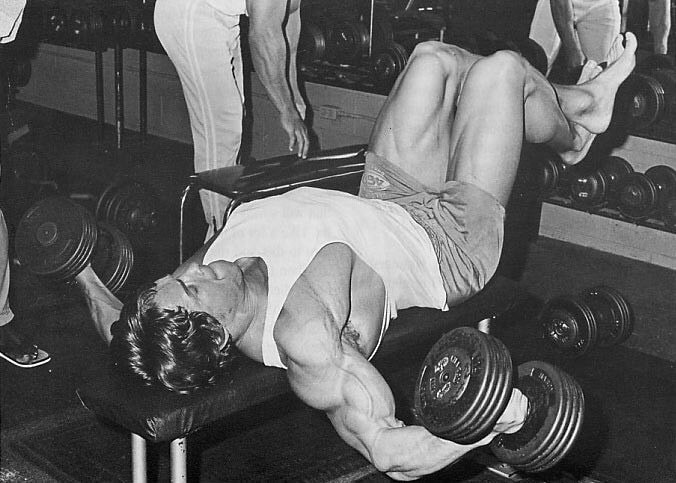Ask almost any bodybuilder how many reps you should do to build muscle, and, in most cases, they’ll tell you 6-12 reps. The 6-12 rep range is all but set in stone, and a large percentage of bodybuilding workouts use this prescription.
The 6-12 rep range is also associated with training with moderate weights, typically 67 to 85 percent of your one repetition maximum, or 1RM for short. Your 1RM is the maximum weight you can lift once but not twice for a given exercise.
You don’t NEED to know your 1RM to work in the 6-12 rep range. So long as you come within a couple of reps of failure within the 6-12 range, you’ll naturally end up using 67-85 percent of your 1RM. It stands to reason that your rep count decreases as you lift more weight, and vice versa.
It’s unclear where the 6-12 rep range comes from, but there is a good chance it’s based on a 1940s study by US army physician Thomas DeLorme.
De Lorme suggested that three sets of ten reps was the most effective method for weight training (1). So, it’s easy to see that the popularity of 6-12 could have come from his recommendation to do sets of ten.
80 years after DeLorme’s study, a lot of research has been done to determine the best way to build muscle and strength. Some of this research suggests that reps outside of the 6-12 range can be just as effective for building muscle.
Level Up Your Fitness: Join our 💪 strong community in Fitness Volt Newsletter. Get daily inspiration, expert-backed workouts, nutrition tips, the latest in strength sports, and the support you need to reach your goals. Subscribe for free!
Can you get bigger and stronger with sets of 20, 30, or even 50 reps? We reveal the (current) truth!
The Mechanisms of Muscle Growth
You need several things to trigger muscle growth, properly called hypertrophy. Because of this, it’s almost impossible to build muscle without following a hypertrophy-specific workout.
So, the next time someone tells you that they don’t lift weights because they “don’t want to get big like Arnie,” you can reassure them that it’s unlikely it’ll happen by accident.

The accepted mechanisms of muscle hypertrophy are (2):
Mechanical tension
Mechanical tension is simply the load on the muscles. This tension triggers a cascade of adaptive responses, ending at the myofibrils or muscle fibers. When tension is sufficient, the myofibrils thicken and may also increase in number.
Muscle damage
Lifting weights, especially when you take your sets close to failure, causes microscopic tears to your muscle tissues. This is a catabolic event. With sufficient rest and adequate nutrition, your muscles grow back bigger and stronger than before, which is an anabolic event.
Muscle growth is a form of self-preservation, and your muscles are protecting themselves from future bouts of intense exercise.
Metabolic stress
Challenging workouts produce a buildup of metabolic waste products within the muscle being trained. These waste metabolites include lactic acid, phosphate inorganic, and hydrogen ions. Research suggests that these substances play a part in muscle growth (3).
Taking your sets close to failure should produce adequate metabolic stress and is characterized by the intense burning and muscle pump that comes with bodybuilding-style workouts.
Can You Build Bigger Muscles with Light Weights and High Reps?
While you can trigger these mechanisms by training in the 6-12 rep range and with moderate weights, research suggests that muscle hypertrophy is not load-dependent and that you can also increase muscle size using higher reps and lighter weights (4).
So long as your workout results in muscle tension, muscle damage, and metabolic stress, your muscles will get bigger even when you train with light weights.
This means that, while the 6-12 rep range is valid, doing more than 12 reps will not prevent you from building muscle. In fact, you can trigger hypertrophy with 20 or even 30 reps, providing you take your sets to within a couple of reps of failure.
It appears that proximity to failure is more of a driver of hypertrophy than staying within a specific rep range.
This means the actual rep range of hypertrophy is about 6-30 reps per set.
However, the same research indicates that loads less than 20% of your 1RM are not so effective for building muscle, so you should not start doing 50 or 100 reps per set (4).
That’s actually good news because very high rep sets take a lot of time and would make your workouts much less time-efficient.
What About Building Strength?
So, research strongly suggests that you can build bigger muscles with light weights and high reps. Providing you take your sets close to failure to create muscle tension, muscle damage, and metabolic stress, your muscles will respond by getting bigger.
But, can you build strength with high reps and low weights?
The answer is yes – and no.
While training with light weights will make you stronger, there is a limit to how much strength you will gain.
Providing you gradually increase your weights or do more reps, your muscles will respond by getting stronger, but those strength increases will be minimal. So, don’t expect to be able to bench 300lb just because you can do 30 reps with 135!
In order to build maximal strength, you must lift heavy weights.
That’s because strength is determined by your ability to recruit a large number of muscle fibers simultaneously. This is a neurological skill, and the only way to practice and achieve this feat is by lifting heavy weights, typically greater than 85% of your 1RM. This magnitude of load will limit you to 1-5 reps per set.
If you want to get stronger, your program should include plenty of heavy lifting, focusing mainly on the 1-5 rep range using compound exercises like squats, deadlifts, and bench presses.
Level Up Your Fitness: Join our 💪 strong community in Fitness Volt Newsletter. Get daily inspiration, expert-backed workouts, nutrition tips, the latest in strength sports, and the support you need to reach your goals. Subscribe for free!
Practical Applications – How to Use This Information
The first thing to stress is that if you are happy training in the 6-12 rep range and are getting good results, there is no real need to change. As the saying goes, if it ain’t broke, don’t fix it.
Another thing to remember is that high rep, low load training is not BETTER than the more common 6-12 rep range. Rather, it will produce very similar results. It’s just a different route to the same destination.
That said, there are situations where training with lighter loads for higher reps may be advantageous. Reasons to include higher rep, lower load training in your workouts include:
Limited weight available
Most commercial gyms have a good supply of weights so that, whatever exercise you are doing, you should be able to choose a load that keeps you within the 6-12 rep range. However, if you train at home or are visiting a less well-equipped gym, you may not have access to enough weight. Hotel gyms are notorious for only having light dumbbells – they don’t usually cater to stronger-than-average bodybuilders.
In these instances, just rep out using whatever weight you’ve got, and don’t worry about going beyond 12 reps. Providing you take your sets close to failure, you will still have a productive hypertrophy workout.
Less joint stress
Heavier weights and lower reps can put a lot of stress on your joints. That’s especially true for most compound or multi-joint exercises. Joint stress may be a non-issue if you are young and healthy but could be a real problem if you are an older exerciser with sore knees, hips, elbows, or shoulders.
Light weights and high reps are often easier on your joints and will allow you to train for hypertrophy without joint pain.
Variety
Variety is the spice of life, or so the old saying goes, and that includes hypertrophy training. Doing the same workout over and over can lead to a progress plateau, and there is nothing more frustrating than training but not seeing any results.
Changing from the standard 6-12 rep range to 20 or even 30 reps per set could be just what you need to reignite your progress. It’s challenging, but in an entirely new way, and it could help you get out of a training rut.
If you notice that your progress is starting to slow, doing something novel is one way to get things moving again. You can change exercises, adopt a different split or, more simply, reduce your weights and do some higher rep sets. This latter adjustment is straightforward to implement.
Another way to use low-load training for rut-busting is to have heavy and light days. Train each muscle twice a week, e.g., using a push-pull-legs split, but use diametrically opposing repetition ranges. For example:
- 1stleg workout – 4 sets of 20-30 reps @ 40-50% of your 1RM, 30-45 seconds rest between sets.
- 2ndleg workout – 4 sets of 6 reps @ 80% of your 1RM, 2-3 minutes rest between sets.
These two very different loading schemes could provide a greater hypertrophic stimulus than training a muscle group twice per week with the same reps and weights.
Limitations to Training with Low Weights and High Reps
Low load, high rep training is as effective for hypertrophy as the more common 6-12 rep range (4). However, there ARE a couple of notable disadvantages to doing sets of 20+ reps:
1. Longer workouts
A set of 20 or more reps will always take longer than a set of six reps. So, if you switch to high-rep training, expect to spend more time in the gym. However, it is worth noting that recovery after a high-rep set may be faster than for low-rep sets, so this issue may balance itself out.
2. Increased cardiovascular demand
Doing high-rep sets of compound exercises will impact your cardiovascular system, increasing your heart and breathing rate. In some instances, cardiovascular fatigue could occur before your muscles reach failure, reducing the hypertrophic effect of your workout.
Because of this, it may be better to stick to lower reps for the more demanding compound lifts and use high reps and low loads for isolation exercises, as they have a much smaller cardiovascular cost.
For example:
- Barbell back squats – 3 sets of 6-8 reps
- Leg press – 3 sets of 10-12 reps
- Leg extensions – 3 sets of 15-20 reps
- Hamstring curls – 3 sets of 15-20 reps
Of course, if you have a high level of cardiovascular conditioning, you should be able to complete a high-rep set without overloading your heart and lungs.
3. Limited strength gains
Unequivocally, if you want to get stronger, you need to lift heavy weights. While low load, high-rep training builds muscle, the lower the percentage of your 1RM used, the less strength you’ll gain.
Low-load training could be a good option if you are only interested in building muscle size. But, if you want to develop size AND strength, you’ll still need to include heavier weights and lower reps in your workouts.
Hypertrophy Training – Wrapping Up
It turns out that the rep range of hypertrophy training is much broader than initially thought. Instead of being limited to 6-12 reps, the actual hypertrophy rep range is more like 6 to 30 reps.
Providing you take your sets close to failure, it doesn’t seem to matter much whether you do six, 16, or 26 reps per set.
However, strength gains are very specific to the type of training performed. If you want to build strength, you need to include heavier loads and lower reps in your workouts.
Finally, if you like training in the 6-12 rep range, there is no reason to stop. But knowing you have the option to build muscle with higher rep sets can be liberating, especially if you only have access to light weights or your own body weight. Providing you train close to failure, even high rep push-ups and lunges can help you build bigger muscles.
References:
1. PubMed: Thomas L. DeLorme and the science of progressive resistance exercise https://pubmed.ncbi.nlm.nih.gov/22592167/
2. PubMed: The mechanisms of muscle hypertrophy and their application to resistance training https://pubmed.ncbi.nlm.nih.gov/20847704/
3. PubMed: Role of metabolic stress for enhancing muscle adaptations https://www.ncbi.nlm.nih.gov/pmc/articles/PMC5489423/
4. PubMed: Effects of different intensities of resistance training with equated volume load on muscle strength and hypertrophy https://pubmed.ncbi.nlm.nih.gov/29564973/











